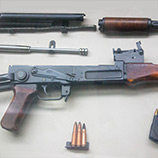 Vienna (Austria), 21 October 2019 - The United Nations Office on Drugs and Crime (UNODC) has, for the first time, made available statistics of illicit firearms trafficking. Comprehensive data on firearms trafficking were gathered, processed and are now made available for public use via the UNODC data portal. While improvements are needed in terms of quality and coverage of the current dataset, the path to improve evidence-based information on firearms trafficking is being traced.
Vienna (Austria), 21 October 2019 - The United Nations Office on Drugs and Crime (UNODC) has, for the first time, made available statistics of illicit firearms trafficking. Comprehensive data on firearms trafficking were gathered, processed and are now made available for public use via the UNODC data portal. While improvements are needed in terms of quality and coverage of the current dataset, the path to improve evidence-based information on firearms trafficking is being traced.
"For the first time ever a comprehensive statistical dataset on illicit firearms seizures is publicly available online. We invite all interested users, including national authorities, researchers, and experts, to make ample use of this dataset to better understand challenges posed by illicit trafficking of firearms and to strengthen countries' response to it" said Enrico Bisogno, Chief of the Data Development and Dissemination Unit at UNODC.
In June 2018, UNODC initiated a process of data collection and analysis on firearms trafficking through the Illicit Arms Flow Questionnaire (IAFQ). This exercise yielded 80 responses to the questionnaire, which were also supplemented by other official sources.
Further to this, UNODC is preparing a global analytical study on firearms trafficking which draws on the dataset resulting from this exercise. This dataset sheds light on several aspects of the black market for firearms, including on quantities and types of firearms seized and trafficked and the nature of the illicit flows, as well as efforts by countries - such as tracing of the illicit origin of firearms - to curtail illicit flows.
The efforts of UNODC in the area of data collection and analysis on firearms trafficking are being undertaken in furtherance of a double mandate: UNODC's role as co-custodian agency for SDG Indicator 16.4.2 ("Proportion of seized, found or surrendered arms whose illicit origin or context has been traced or established by a competent authority in line with international instruments") as well as relevant resolutions of the Conference of the Parties to the United Nations Convention against Transnational Organized Crime. In particular, resolution 9/2 requested UNODC to continue to share and disseminate its findings on best practices, the dimensions and characteristics of firearms trafficking, and lessons learned.
This work is being carried out in the framework of the project "Supporting Global Data Collection and Analysis on Firearms Trafficking and Fostering Cooperation and Information Sharing, in particular Among Countries along Major Trafficking Routes to/from the EU", jointly implemented by the Global Firearm Program and the Research and Trends Analysis Branch.